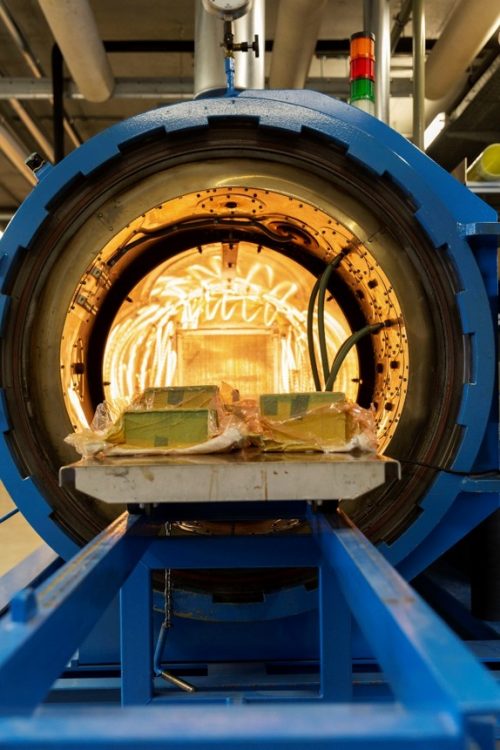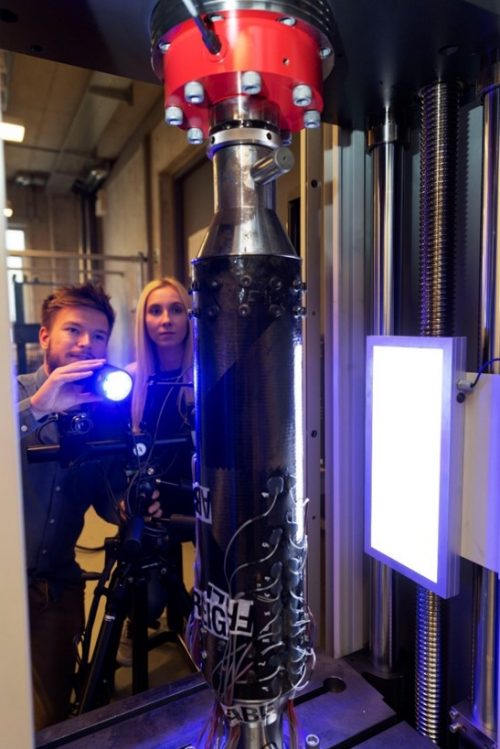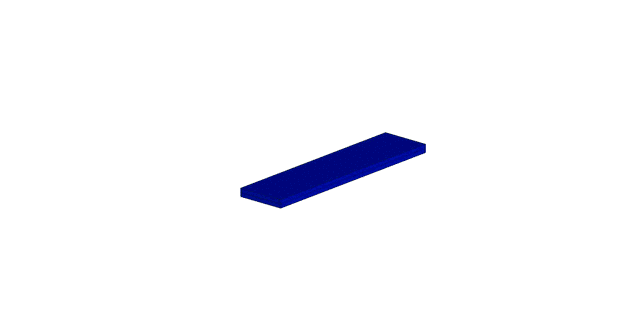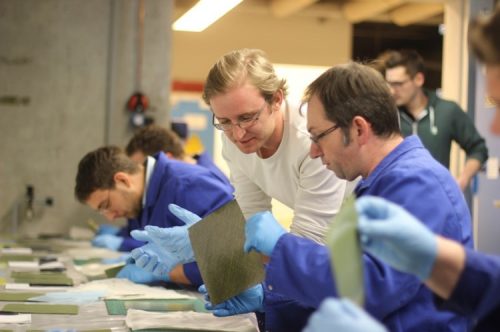2024
|
Kastenmeier, A.; Siegl, M.; Ehrlich, I.; Gebbeken, N. Review of elasto-static models for three-dimensional analysis of thick-walled anisotropic tubes Leichtbau Artikel In: Journal of Composite Materials, Bd. 58, Ausg. 7, S. 923-951, 2024, ISSN: 0021-9983. @article{Kastenmeier2023,
title = {Review of elasto-static models for three-dimensional analysis of thick-walled anisotropic tubes},
author = {A. Kastenmeier and M. Siegl and I. Ehrlich and N. Gebbeken},
doi = {10.1177/00219983231215863},
issn = {0021-9983},
year = {2024},
date = {2024-03-01},
urldate = {2023-11-28},
journal = {Journal of Composite Materials},
volume = {58},
issue = {7},
pages = {923-951},
publisher = {SAGE Publications},
abstract = {Most shell or beam models of anisotropic tubes under bending have no validity for thick-walled structures. As a result, the need to develop three-dimensional formulations which allow a change in the stress, strain and displacement distributions across the radial component arises. Basic formulations on three-dimensional anisotropic elasticity were made either stress- or displacement-based by Lekhnitskii or Stroh on plates. Lekhnitskii also was the first to expand these analytical formulations to tubes under various loading conditions. This paper presents a review of the stress and strain analysis of tube models using three-dimensional anisotropic elasticity. The focus lies on layered structures, like fiber-reinforced plastics, under various bending loads, although the basic formulations and models regarding axisymmetric loads are briefly discussed. One section is also dedicated to the determination of an equivalent bending stiffness of tubes.},
keywords = {},
pubstate = {published},
tppubtype = {article}
}
Most shell or beam models of anisotropic tubes under bending have no validity for thick-walled structures. As a result, the need to develop three-dimensional formulations which allow a change in the stress, strain and displacement distributions across the radial component arises. Basic formulations on three-dimensional anisotropic elasticity were made either stress- or displacement-based by Lekhnitskii or Stroh on plates. Lekhnitskii also was the first to expand these analytical formulations to tubes under various loading conditions. This paper presents a review of the stress and strain analysis of tube models using three-dimensional anisotropic elasticity. The focus lies on layered structures, like fiber-reinforced plastics, under various bending loads, although the basic formulations and models regarding axisymmetric loads are briefly discussed. One section is also dedicated to the determination of an equivalent bending stiffness of tubes. |
Pongratz, C.; Tix, J.; Wolfrum, J.; Gerke, S.; Ehrlich, I.; Brünig, M. Test Setup for Investigating the Impact Behavior of Biaxially Prestressed Composite Laminates Leichtbau Artikel In: Exp Tech, 2024, ISSN: 1747-1567. @article{Pongratz2024,
title = {Test Setup for Investigating the Impact Behavior of Biaxially Prestressed Composite Laminates},
author = {C. Pongratz and J. Tix and J. Wolfrum and S. Gerke and I. Ehrlich and M. Brünig},
doi = {10.1007/s40799-024-00701-4},
issn = {1747-1567},
year = {2024},
date = {2024-02-08},
urldate = {2024-02-08},
journal = {Exp Tech},
publisher = {Springer Science and Business Media LLC},
abstract = {Instrumented impact testing and compression-after-impact testing are important to adequately qualify material behavior and safely design composite structures. However, the stresses to which fiber-reinforced plastic components are typically subjected in practice are not considered in the impact test methods recommended in guidelines or standards. In this paper, a test setup for investigating the impact behavior of composite specimens under plane uniaxial and biaxial preloading is presented. For this purpose, a special test setup consisting of a biaxial testing machine and a specially designed drop-weight tower was developed. The design decisions were derived from existing guidelines and standards with the aim of inducing barely visible impact damage in laminated carbon fiber-reinforced plastic specimens. Several measurement systems have been integrated into the setup to allow comprehensive observation of the impact event and specimen behavior. A feasibility test was performed with biaxially prestressed carbon fiber-reinforced plastic specimens in comparison with unstressed reference tests. The compressive-tensile prestressing resulted in lower maximum contact forces, higher maximum deflections, higher residual deflections and a different damage pattern, which was investigated by light microscopic analysis. Finally, the functionality of the experimental setup is discussed, and the results seem to indicate that the test setup and parameters were properly chosen to investigate the effect of prestresses on the impacts behavior of composite structures, in particular for barely visible subsequent damages.},
keywords = {},
pubstate = {published},
tppubtype = {article}
}
Instrumented impact testing and compression-after-impact testing are important to adequately qualify material behavior and safely design composite structures. However, the stresses to which fiber-reinforced plastic components are typically subjected in practice are not considered in the impact test methods recommended in guidelines or standards. In this paper, a test setup for investigating the impact behavior of composite specimens under plane uniaxial and biaxial preloading is presented. For this purpose, a special test setup consisting of a biaxial testing machine and a specially designed drop-weight tower was developed. The design decisions were derived from existing guidelines and standards with the aim of inducing barely visible impact damage in laminated carbon fiber-reinforced plastic specimens. Several measurement systems have been integrated into the setup to allow comprehensive observation of the impact event and specimen behavior. A feasibility test was performed with biaxially prestressed carbon fiber-reinforced plastic specimens in comparison with unstressed reference tests. The compressive-tensile prestressing resulted in lower maximum contact forces, higher maximum deflections, higher residual deflections and a different damage pattern, which was investigated by light microscopic analysis. Finally, the functionality of the experimental setup is discussed, and the results seem to indicate that the test setup and parameters were properly chosen to investigate the effect of prestresses on the impacts behavior of composite structures, in particular for barely visible subsequent damages. |
2023
|
Olbrich, F.; Pongratz, C.; Bierl, R.; Ehrlich, I. Method and system for evaluating a structural integrity of an aerial vehicle Leichtbau Patent 2023. @patent{nokey,
title = {Method and system for evaluating a structural integrity of an aerial vehicle},
author = {F. Olbrich and C. Pongratz and R. Bierl and I. Ehrlich},
editor = {United States Patent},
year = {2023},
date = {2023-12-05},
urldate = {2023-12-05},
issue = {US11835425B2},
abstract = {A method of evaluating a structural integrity of an aerial vehicle comprising one or more engines comprises selectively driving said engine/s of said aerial vehicle according to a driving pattern unsuitable to put or maintain the aerial vehicle in flight, recording a vibrational response of at least a part of the aerial vehicle to said selective driving of said engine/s, determining a plurality of modal parameters of said vibrational response, in particular an eigenfrequency of said vibrational response and/or a damping factor corresponding to said eigenfrequency, and classifying said structural integrity based on a deviation of said plurality of modal parameters from baseline modal parameters for said aerial vehicle.},
key = {US11835425B2},
keywords = {},
pubstate = {published},
tppubtype = {patent}
}
A method of evaluating a structural integrity of an aerial vehicle comprising one or more engines comprises selectively driving said engine/s of said aerial vehicle according to a driving pattern unsuitable to put or maintain the aerial vehicle in flight, recording a vibrational response of at least a part of the aerial vehicle to said selective driving of said engine/s, determining a plurality of modal parameters of said vibrational response, in particular an eigenfrequency of said vibrational response and/or a damping factor corresponding to said eigenfrequency, and classifying said structural integrity based on a deviation of said plurality of modal parameters from baseline modal parameters for said aerial vehicle. |
Bartsch, A.; Beham, D.; Gebhardt, J.; Ehrlich, I.; Schratzenstaller, T. Mechanical Properties of NdPrFeB Based Magnetoactive Bisphenol- Free Boron-Silicate Polymers Leichtbau Artikel In: J Nanomed Nanotech, Ausg. 14: 705, 2023. @article{Bartsch2023,
title = {Mechanical Properties of NdPrFeB Based Magnetoactive Bisphenol- Free Boron-Silicate Polymers},
author = {A. Bartsch and D. Beham and J. Gebhardt and I. Ehrlich and T. Schratzenstaller},
url = {https://www.walshmedicalmedia.com/open-access/mechanical-properties-of-ndprfeb-based-magnetoactive-bisphenolfree-boronsilicate-polymers-124385.html},
doi = {10.35248/2157-7439.23.14.705},
year = {2023},
date = {2023-11-30},
urldate = {2023-11-30},
journal = {J Nanomed Nanotech},
issue = {14: 705},
abstract = {Following a ban on many materials containing bisphenol-A, new bisphenol-free Boron silicates have been found as substitutes. The purpose of this study is to describe the mechanical properties of these bisphenol-free magnetoactive borosilicate polymers containing hard magnetic particles. Samples of 0%, 33% and 66% by wt. were loaded for compression using a universal testing machine. The maximum forces occurring for different travel speeds were compared before and after post-magnetization treatments. The post-magnetization included 2 stages. In addition, the change in mechanical properties within 24 hours after the post-magnetization process was investigated. Furthermore, the influence of speed and particle content were investigated. In general, there is a correlation between the required compressive force and, the level of post-magnetization stress, the increase in travel speed and particle content in the boron silicate. Comparison of the non-post-magnetized and post-magnetized samples using two-tailed t-tests shows that the p-values for all weight fraction changes in NdPrFeB particles and travel speeds are less than 0.001. Also, a comparison between tests in which the traverse speed was varied also showed significant changes in the resulting compression forces. The same is valid for changes in the weight ratio of the NdPrFeB particles in the samples. For post-magnetized samples, no significant difference can be observed in the first 24 hours following magnetization. In summary, the material presents viscoelastic, plastic force-displacement behavior, which can be well recognized by its bi-linear curve shape. The investigation shows that borosilicate polymers based on NdPrFeB can have their mechanical behavior modified and controlled by post-magnetization processes. This opens new possibilities for many future applications.},
keywords = {},
pubstate = {published},
tppubtype = {article}
}
Following a ban on many materials containing bisphenol-A, new bisphenol-free Boron silicates have been found as substitutes. The purpose of this study is to describe the mechanical properties of these bisphenol-free magnetoactive borosilicate polymers containing hard magnetic particles. Samples of 0%, 33% and 66% by wt. were loaded for compression using a universal testing machine. The maximum forces occurring for different travel speeds were compared before and after post-magnetization treatments. The post-magnetization included 2 stages. In addition, the change in mechanical properties within 24 hours after the post-magnetization process was investigated. Furthermore, the influence of speed and particle content were investigated. In general, there is a correlation between the required compressive force and, the level of post-magnetization stress, the increase in travel speed and particle content in the boron silicate. Comparison of the non-post-magnetized and post-magnetized samples using two-tailed t-tests shows that the p-values for all weight fraction changes in NdPrFeB particles and travel speeds are less than 0.001. Also, a comparison between tests in which the traverse speed was varied also showed significant changes in the resulting compression forces. The same is valid for changes in the weight ratio of the NdPrFeB particles in the samples. For post-magnetized samples, no significant difference can be observed in the first 24 hours following magnetization. In summary, the material presents viscoelastic, plastic force-displacement behavior, which can be well recognized by its bi-linear curve shape. The investigation shows that borosilicate polymers based on NdPrFeB can have their mechanical behavior modified and controlled by post-magnetization processes. This opens new possibilities for many future applications. |
Gebhardt, J.; Schlamp, M.; Ehrlich, I.; Hiermaier, S. Low-velocity impact behavior of elliptic curved composite structures Leichtbau Artikel In: International Journal of Impact Engineering, Bd. 180, S. 104663, 2023, ISSN: 0734-743X. @article{GEBHARDT2023104663,
title = {Low-velocity impact behavior of elliptic curved composite structures},
author = {J. Gebhardt and M. Schlamp and I. Ehrlich and S. Hiermaier},
url = {https://www.sciencedirect.com/science/article/pii/S0734743X23001744},
doi = {https://doi.org/10.1016/j.ijimpeng.2023.104663},
issn = {0734-743X},
year = {2023},
date = {2023-01-01},
urldate = {2023-01-01},
journal = {International Journal of Impact Engineering},
volume = {180},
pages = {104663},
abstract = {Although many composite structures are inconsistently curved, such as the leading edges of aircraft wings, the variety of research in impact engineering is almost limited to the impact performance of plates or cylindrically curved specimens. It is not known whether the findings obtained from standardized tests can be transferred to curved structures or which adaptions are required. Therefore, a deeper understanding of the deformation and damage behavior of inconsistently curved structures is essential to transfer the observed impact behavior of flat specimens to general curved structures and therefore to utilize the full lightweight potential of a load-specific design. An accurate description of the procedure as well as the results of the experimental and numerical study of the low-velocity impact behavior of differently single-curved elliptic specimens is presented. To close the research gap of the impact behavior of geometries with curvatures between the plates and simplified leading edges, novel specimens geometries have been derived from established impact test standards. Glassfiber-reinforced specimens are subjected to an instrumented impact test at constant impact energy. This is numerically investigated by a stacked-layer model, which used cohesive zone modeling to enable the simulation of matrix cracking, fiber fracture and delamination. The resulting projected damage areas, as well as the force and deflection histories, were evaluated and section cuts were examined to discuss the damage morphology, formation and propagation process. Significant effects on maximum deflection, compliance and dynamic behavior on the size and morphology of damage were found.},
keywords = {},
pubstate = {published},
tppubtype = {article}
}
Although many composite structures are inconsistently curved, such as the leading edges of aircraft wings, the variety of research in impact engineering is almost limited to the impact performance of plates or cylindrically curved specimens. It is not known whether the findings obtained from standardized tests can be transferred to curved structures or which adaptions are required. Therefore, a deeper understanding of the deformation and damage behavior of inconsistently curved structures is essential to transfer the observed impact behavior of flat specimens to general curved structures and therefore to utilize the full lightweight potential of a load-specific design. An accurate description of the procedure as well as the results of the experimental and numerical study of the low-velocity impact behavior of differently single-curved elliptic specimens is presented. To close the research gap of the impact behavior of geometries with curvatures between the plates and simplified leading edges, novel specimens geometries have been derived from established impact test standards. Glassfiber-reinforced specimens are subjected to an instrumented impact test at constant impact energy. This is numerically investigated by a stacked-layer model, which used cohesive zone modeling to enable the simulation of matrix cracking, fiber fracture and delamination. The resulting projected damage areas, as well as the force and deflection histories, were evaluated and section cuts were examined to discuss the damage morphology, formation and propagation process. Significant effects on maximum deflection, compliance and dynamic behavior on the size and morphology of damage were found. |



















